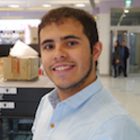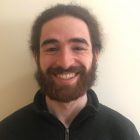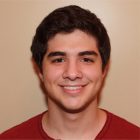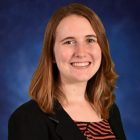Bernardo is a PhD student in mechanical engineering whose research examines the synthesis of robust strategies for grasping and dexterous manipulation. Specifically, he is examining the problem of caging, a geometric property by which a set of fingers manipulate an object by trapping it rather than immobilizing it. He has developed an explicit optimization approach to formulate the caging condition as a convex mixed-integer optimization problem. This was the first of its kind, since caging had previously been approached as either a topological or computational geometry problem. More recently, he has extended the formulation to synthesizing grasping strategies with certificates of correctness, a problem that is of high interest today both in academia and industry. He uses MATLAB’s Robotics Toolbox, Optimization Toolbox, and Deep Learning Toolbox as the main prototyping interface. In addition, his work has resulted in several tools that have been made open to the robotics and MathWorks communities, including ABB ROS Interface, Contact-TrajectoryOptimization Models, and Certified Grasping Toolbox. Bernando earned a BSc in electronics engineering from Universidad Simón Bolívar, Venezuela
https://engineering.mit.edu/wp-content/uploads/Aceituno-Bernardo.jpg
Website
Bernardo Aceituno - Cabeza
Mechanical Engineering https://engineering.mit.edu/fellows/bernardo-aceituno-cabeza/Shashank is a PhD student in mechanical engineering whose research primarily focuses on the development of reduced-order, rate-dependent methods for a variety of granular intrusion problems, such as meteorite impacts and animal and vehicular locomotion in sands and deserts (a field referred to as terramechanics). He uses large-scale, detailed numerical simulations to understand the physics of such scenarios, which in turn allows him to develop robust reduced-order models that can be run in real time. He uses MATLAB for various purposes in his research, most importantly for the implementation of reduced-order models for granular intrusion, allowing for the real-time simulation of diverse intrusion scenarios with different system properties and intruder shapes. Shashank earned a BTech in mechanical engineering fromIITGandhinagar, India and an SM in mechanical engineering from MIT.He also worked as a scientist at the Defense Research and Development Organization, India before joining MIT
https://engineering.mit.edu/wp-content/uploads/Agarwal-Shashank.jpg
Website
Shashank Agarwal
Mechanical Engineering https://engineering.mit.edu/fellows/shashank-agarwal/Mohammad is a PhD student in civil and environmental engineering whose research is focused on explaining and predicting biodiversity changes using mathematical models. Specifically, his goal is to provide closed-form solutions using computational methods in order to skip the impossible task of simulating all possible parameter values and combinations and to establish rigorous and testable estimates about the probability of persistence of species. He is developing his own code and integrating libraries from MATLAB with the goal of generating a computational package that will allow researchers to work with different ecological models, derive the range of parameter values (or combinations of parameter values) compatible with the persistence of a given species in an ecological system, and estimate the probabilities (or risks) of species extinctions or species invasions. Mohammad earned a BS in mathematics and a BS in electrical engineering from Rensselaer Polytechnic Institute and an SM in civil and environmental engineering, an SM in electrical engineering and computer science, and an SM in computation for design and optimization from MIT.
https://engineering.mit.edu/wp-content/uploads/Aladwani-Mohammad.jpg
Website
Mohammad AlAdwani
Civil and Environmental Engineering https://engineering.mit.edu/fellows/mohammad-aladwani/Nicolas is a PhD student in electrical engineering and computer science whose research focuses on medical imaging technology. He is trying to solve challenging MRI problems by creating and distributing the hardware and computational tools needed for simultaneous optimization of coil geometries, encoding field patterns, and received-signal reconstruction algorithms. He has observed that the steps, or modules, that make up most MRI sequences often have conflicting patient-specific field pattern requirements. Nicolas developed a general MATLAB-based framework for use at scan time that optimizes the field patterns for each sequence module. The framework reads patient rapid-scan data from the imager, exploits the coil pre-characterization and convex formulations to efficiently compute sets of sequence-module optimized coil currents, and then transfers the coil currents sets, along with triggering conditions, to the coil driver array. Nicolas earned an SB in electrical engineering from MIT.
https://engineering.mit.edu/wp-content/uploads/Arango-Nicolas.jpg
Website
Nicolas Arango
Electrical Engineering and Computer Science https://engineering.mit.edu/fellows/nicolas-arango/A PhD student in electrical engineering and computer science, Roberto is a member of the Organic and Nanostructured Electronics Lab. He uses MATLAB’s versatile Partial Differential Equation (PDE), Global Optimization, and ParallelComputingToolboxes to solve, model, and fit the group’s experimental data sets on carrier recombination and diffusion in semiconductors for optoelectronic applications. Leveraging the PDE Toolbox, his most recent work, “AccurateDetermination of Semiconductor Diffusion Coefficient Using Confocal Microscopy,” explores common pitfalls in modeling charge carrier diffusion in semiconductors that were elucidated by simulations carried out using the PDE toolbox. He is now focused on modeling semiconductors for solar applications that present anisotropic diffusion and complex boundaries using the PDE Toolbox coupled with the Parallel Computing and the Global Optimization Toolboxes to optimize multi-variable minimization problems. The Parallel Computing Toolbox has been essential in bringing the computation times down to manageable time frames, allowing him to explore multiple schemes that could represent the complex carrier diffusion anisotropy that is observed. He earned an SB in electrical engineering and physics fromMIT.
https://engineering.mit.edu/wp-content/uploads/Brenes-Roberto.jpg
Website
Roberto Brenes
Electrical Engineering and Computer Science https://engineering.mit.edu/fellows/roberto-brenes/Katherine is a master’s student in aeronautical and astronautical engineering and member of the Engineering SystemsLaboratory. A longtime MATLAB and Simulink user, her current research involves population modeling and simulation of pedestrian activity through transit environments. She is implementing agent-based modeling and simulation in order to capture the emergent phenomena of population groups moving across complex sites, both here on Earth and on Mars. She has used MATLAB to numerically simulate pedestrian flows in hallways using a social-force model and is currently developing a Java-based integrated, flexible platform to simulate agent behavior across multiple agent pools and simulation scenarios. Katherine earned a BS in aerospace engineering fromUniversity of Illinois.
https://engineering.mit.edu/wp-content/uploads/Carroll-Katherine.jpg
Website
Katherine Carroll
Aeronautics and Astronautics https://engineering.mit.edu/fellows/katherine-carroll/Cécile is a PhD student in materials science and engineering. Her research is focused on the creation of new methods for manufacturing high-performance polymer and composite materials in a rapid, energy-efficient manner. Specifically, she studies interfacial polymerization (IP), a process by which a polymer is formed at the interface between two immiscible liquids (often water and an organic solvent), each containing one type of reactive species (initiator or monomer). She uses MATLAB to enable experimental data analysis and prediction of IP-based process kinetics, as well as future perspective on the integration of MATLAB algorithms in manufacturing and 3D printing. Cécile earned an MS in materials science and engineering from MINES ParisTech, France.
https://engineering.mit.edu/wp-content/uploads/Chazot-Cecile.jpg
Website
Cécile Chazot
Materials Science and Engineering https://engineering.mit.edu/fellows/cecile-chazot/Ximo is a PhD student in aeronautics and astronautics conducting research at the intersection of numerical modeling and physics of nanoscale engineering devices. A frequent MATLAB user, he is working on a problem related to the numerical analysis of the shapes of small liquid menisci stressed under very high electric fields to evaporate ions. As these ions fly away, they produce thrust, hence a rocket can be constructed under this principle. This is difficult to analyze since the scales change dramatically from millimeters to nanometers, which creates a set of numerical challenges as equations describing the balance of electric, surface tension, and hydraulic stresses, including thermal loads that need to be solved simultaneously on meshes with very strong dimensional gradients. He earned a BS in aeronautics and astronautics and physics from Universitat Politècnica de Catalunya, Spain
https://engineering.mit.edu/wp-content/uploads/Cidoncha-Ximo.jpg
Website
Ximo Gallud Cidoncha
Aeronautics and Astronautics https://engineering.mit.edu/fellows/ximo-gallud-cidoncha/Clement is a PhD student in aeronautics and astronautics working on aviation automation problems at the MITInternational Center for Air Transportation. His PhD topic involves investigating high-level aviation automation in dynamic and stochastically varying environments. In particular, he is focusing on automated situation awareness and decision making with regards to airborne trajectory prediction. He is investigating data analytics approaches, usingMATLAB tools, for mining large sets of aircraft surveillance (ADS-B) data to infer aircraft behavior in structured and unstructured airspaces around airports. Clement earned a BS in mechanical and aerospace engineering from Princeton University and an SM in aeronautics and astronautics from MIT.
https://engineering.mit.edu/wp-content/uploads/Clement-Li.jpg
Website
Li Clement
Aeronautics and Astronautics https://engineering.mit.edu/fellows/li-clement/Logan is a PhD student in electrical engineering and computer science. His research focuses on intersecting areas in traditional machine learning, deep learning, and statistical analysis. He is particularly interested in making machine learning more robust and reliable and in making AI more human aligned. Much of his research focuses on adversarial examples or imperceptibly changed inputs that can induce worst-case behavior in machine learning systems. He recently completed a statistical analysis with the help of MATLAB’s interface and toolboxes. In the future, he plans to use the simulation capabilities of MathWorks software (e.g., with Unreal Engine) to complete his domain adaptation and transfer learning research, and the Signal Processing Toolbox to better understand non-robust features. Logan earned an SB in computer science from MIT.
https://engineering.mit.edu/wp-content/uploads/Engstrom.jpg
Website
Logan Engstrom
Electrical Engineering and Computer Science https://engineering.mit.edu/fellows/logan-engstrom/Hannah is a PhD student in mechanical engineering whose research is centered on the fundamental design, optimization, and device integration of dynamically reconfigurable micro-scale fluid droplet morphologies for biomedical sensing and imaging. Being able to determine whether bacteria are alive or dead has important implications for rapid detection of pathogenic bacteria presence and the quantification of antibiotic effectiveness. This can be accomplished through sensing optical changes.Hannah is advancing sensing concepts that are based on employing micro-scale, bi-phase emulsion droplets for the optical quantification of bacteria motion to readily distinguish between live and dead bacteria. MATLAB is critical for in-situ assessment of the droplets’ optical characteristics and for computational deduction of the underlying bacteria dynamics. If successful, her approach, which involves efficient data capture and analysis enabled by MATLAB, will address drawbacks in sensitivity, delay times, and cost of bacterial culture and polymerase chain reaction approaches, given that her detection strategy is rapid and the required fluid morphologies are relatively inexpensive to fabricate. Hannah earned a BS in mechanical engineering from Schreyer Honors College at Pennsylvania State University.
https://engineering.mit.edu/wp-content/uploads/Feldstein.jpg
Website
Hannah Feldstein
Mechanical Engineering https://engineering.mit.edu/fellows/hannah-feldstein/Baoliang is a PhD student in mechanical engineering whose research focuses on developing novel label-free microscopy techniques for biological imaging and material inspection. He recently developed a polarization interference microscopy called Quantitative Polarization Interference Microscopy (QPIM). This novel optical imaging technique realized single-shot quantitative polarization imaging, which can capture and analyze the high-speed dynamics happened in anisotropic samples. With QPIM, he can record the transient retardance of the changing dynamics occurring in a liquid crystal device. He used MATLAB to build a comprehensive polarization parameter retrieval algorithm for QPIM that allows the processing and analyzing of the recorded images. Baoliang earned a BS in information engineering (optoelectronics)from Zhejiang University, China and an SM in mechanical engineering from MIT.
https://engineering.mit.edu/wp-content/uploads/Ge.jpg
Website
Baoliang Ge
Mechanical Engineering https://engineering.mit.edu/fellows/baoliang-ge/Fiona is a PhD student mechanical engineering. Her research Global Engineering and Research (GEAR) Lab focuses on designing low-cost, solar-powered drip irrigation systems for small farms in the Middle East, North Africa, and East Africa. Her goal is to improve and expand the optimization design tool for drip irrigation systems, using a modular design tool that facilitates rapid iterations and improvements. In order to identify further cost-saving design configurations, she is working on co-optimizing the system operation scheme with the design of the drip system components. She is using MATLAB to design and test the behavior of an adaptive pump controller that ensures the drip network and pump operating points are optimally paired for minimal power usage throughout the irrigation season. Fiona earned an SB andSM in mechanical engineering from MIT.
https://engineering.mit.edu/wp-content/uploads/Grant-Fiona.jpg
Website
Fiona Grant
Mechanical Engineering https://engineering.mit.edu/fellows/fiona-grant/Daisy is a PhD student in electrical engineering and computer science working in the Electromechanical Systems Group.Her research is focused on the signal processing and analysis required to create new systems for the automation of energy conservation and for providing actionable insight into the operation of an electrical system and its individual loads. MATLAB was essential to her understanding of machine learning concepts.Her work usesphysics-informed machine learning techniques to identify shipboard loads from an aggregate power stream, track degrading equipment health over time, and detect faults that waste energy.Her work has enabled the expansion of the energy monitoring system to more marine vessels and sites and she will be using MATLAB to analyze this new data.Daisy earned a BS in electrical engineering from University of Hawaii, Manoa.
https://engineering.mit.edu/wp-content/uploads/Green-Daisy.jpg
Website
Daisy Green
Electrical Engineering and Computer Science https://engineering.mit.edu/fellows/daisy-green/Abhinav is a PhD student in mechanical engineering and computation who is developing state-of-the-art algorithms and methodologies for uncertainty quantification, Bayesian learning, deep learning, and numerical methods for various ocean applications. His research in the past years has focused on the problem of sustainable fisheries management inIndia. Due to the high-dimensional nature of ocean modeling and the operational requirements of making ocean predictions in real time, legacy codes written in programming languages such as Fortran are used. While they provide computational speed, they are notoriously difficult to code, edit, and debug. Acting as a bridge, Abhinav is usingMATLAB as a sandbox to develop and test new theories and algorithms before implementing them in the legacy ocean models. He earned a BS and MS in mechanical engineering, both from Indian Institute of Technology Kanpur, India.
https://engineering.mit.edu/wp-content/uploads/Gupta-Abhinav.jpg
Website
Abhinav Gupta
Mechanical Engineering https://engineering.mit.edu/fellows/abhinav-gupta/R’mani is a PhD student in electrical engineering and computer science. She uses MATLAB to create figures such as confusion matrices, and to perform computations on an emerging area in the speech field that revolves around measuring health-related biomarkers from speech. She plans to use the Statistics and Machine Learning Toolbox to automatically detect cognitive impairment from speech. R’mani earned a BS in electrical engineering from Yale University.
https://engineering.mit.edu/wp-content/uploads/Haulcy-Rmani.jpg
Website
R’mani Haulcy
Electrical Engineering and Computer Science https://engineering.mit.edu/fellows/rmani-haulcy/Justin is a PhD student in electrical engineering and computer science and a member of the Spintronic Material and Device Group. His research focuses on the theoretical understanding and experimental realization of spintronics. MATLAB has played a significant role in his research, ranging from experimental measurement, data analysis, and visualization to theoretical calculation of electronic bands and theoretical modeling of magnetic dynamics. With the help of the Instrument Control Toolbox, he uses MATLAB to control the measurement instruments and acquire data through GPIB Interface for Instrument Control. MATLAB also allows him to process and plot the data while measurements are ongoing, providing quick feedback of measurement setup. Moreover, the function overloading in MATLAB enables him to use the same program for handling various instruments with the same functionality. Using MATLAB programs, he was able to theoretically predict coupled magnetic resonance spectrum, which led to subsequent experimental discoveries. He is currently using MATLAB programs for analyzing micromagnetic simulations with GPU acceleration and is incorporating the photon coupling effect into micromagnetics. Justin earned a BS in electrical engineering and a BS in physics, both from National Taiwan University, Taiwan.
https://engineering.mit.edu/wp-content/uploads/Hou-Justin.jpg
Website
Justin Hou
Electrical Engineering and Computer Science https://engineering.mit.edu/fellows/justin-hou/Ifueko is a PhD student in electrical engineering and computers cience. Her research focuses on how computer scientistscan utilize the power of multi-agent collaboration to coordinate swarms of drones completing classic computer vision tasks with extremely high speed and accuracy. The goal of this work is to develop innovative deep-learning models supported by a backbone of drone swarm perception to provide real-time, deep-learning capabilities for autonomous systems. This approach aims to show that leveraging deep learning with multiple low-cost sensors can achieve on-par or improved accuracy compared to expensive sensors.During her first research project at MIT, she was able to learn about many of MATLAB’s custom features for deep learning, which allow for model interoperability and co-execution between different deep learning frameworks. This has enabled her to understand and convert a custom MATLAB deep-learning model that supported sparsely interconnected networks to Pytorch. This facilitated the sharing of weights and the leveraging of favorable training and evaluation conditions within the two frameworks.She earned a BS in computer science and an MS in electrical engineering from Stanford University.
https://engineering.mit.edu/wp-content/uploads/Igbinedion-Ifueko.jpg
Website
Ifueko Nosakhare Igbinedion
Electrical Engineering and Computer Science https://engineering.mit.edu/fellows/ifueko-nosakhare-igbinedion/Yoonho is a PhD student in mechanical engineering. He developed a submillimeter-scale, soft-bodied continuum robot (a type of slender, thread-like robot) capable of slithering through highly complex and constrained environments, such as the narrow and tortuous vasculature of the human brain.Based on this technology, he is developing a telerobotic neurointerventional platform to enable robotic applications to endovascular neurosurgery and stroke treatments. He uses MATLAB for simulation and quantitative prediction of the behavior of the soft continuum robot, and uses MATLAB and Simulink to design the interface for real-time control and teleoperation of the robot arm to remotely control the soft continuum robot.He is also developing data-driven control strategies for autonomous navigation of the soft continuum robots by applying emerging techniques of machine learning. In collaborations with clinicians at Harvard University and Massachusetts General Hospital, he plans to conduct translational studies and preclinical testing to evaluate the safety and efficacy of the developed platform for robotic endovascular neurosurgery. Yoonho earned a BS in mechanical and aerospace engineering from Seoul National University, Korea.
https://engineering.mit.edu/wp-content/uploads/Kim-Yoonho.jpg
Website
Yoonho Kim
Mechanical Engineering https://engineering.mit.edu/fellows/yoonho-kim/Abinash is a PhD student in the Department of Materials Science and Engineering. His research involves atomic-scale characterization of materials using scanning transmission electron microscopy (STEM). He focuses on two aspects of electron microscopy: developing new tools for acquiring high quality data; and extracting local chemical and structural information in materials, using various statistical tools. With the discovery of aberration correctors for electron microscopes, acquiring images of various materials at anatomic scale has become common, yet extracting quantitative information from such images is still challenging. Abinash has implemented a revolving STEM based approach to simultaneously acquired images to correct drift and scan distortions in the musing MATLAB programs.Further, he uses correlation analysis to determine various inhomogeneities, like chemical and structural ordering, which drive the unique spatial pattern in polarization leading to the relaxor behavior. He also applies learning tools like convolutional neural networks for obtaining information, like sample mistilt and thickness, from position averaged convergent beam electron diffraction (PACBED) patterns.He also uses MATLAB to automate the process of generation of simulated PACBED patterns and applied image augmentations for neural networks. Abinash earned a BS and MS in materials at Indian Institute of Science, India.
https://engineering.mit.edu/wp-content/uploads/Kumar-Abinash.jpg
Website